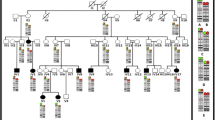Abstract
High resolution cytogenetics, microsatellite marker analyses, and fluorescence in situ hybridization were used to define Xq deletions encompassing the fragile X gene, FMR1, detected in individuals from two unrelated families. In Family 1, a 19-year-old male had facial features consistent with fragile X syndrome; however, his profound mental and growth retardation, small testes, and lover limb skeletal defects and contractures demonstrated a more severe phenotype, suggestive of a contiguous gene syndrome. A cytogenetic deletion including Xq26.3–q27.3 was observed in the proband, his phenotypically normal mother, and his learning-disabled non-dysmorphic sister. Methylation analyses at the FMR1 and androgen receptor loci indicated that the deleted X was inactive in > 95% of his mother’s white blood cells and 80–85% of the sister’s leukocytes. The proximal breakpoint for the deletion was approximately 10 Mb centromeric to FMR1, and the distal breakpoint mapped 1 Mb distal to FMR1. This deletion, encompassing ∼13 Mb of DNA, is the largest deletion including FMR1 reported to date. In the second family, a slightly smaller deletion was detected. A female with moderate to severe mental retardation, seizures, and hypothyroidism, had a de novo cytogenetic deletion extending from Xq26.3 to q27.3, which removed ∼12 Mb of DNA around the FMR1 gene. Cytogenetic and molecular data revealed that ∼50% of her white blood cells contained an active deleted X. These findings indicate that males with deletions including Xq26.3–q27.3 may exhibit a more severe phenotype than typical fragile X males, and females with similar deletions may have an abnormal phenotype if the deleted X remains active in a significant proportion of the cells. Thus, important genes for intellectual and neurological development, in addition to FMR1, may reside in Xq26.3–q27.3. One candidate gene in this region, SOX3, is thought to be involved in neuronal development and its loss may partly explain the more severe phenotypes of our patients.
Similar content being viewed by others
Author information
Authors and Affiliations
Additional information
Received: 19 December 1996 / Accepted: 13 March 1997
Rights and permissions
About this article
Cite this article
Wolff, D., Gustashaw, K., Zurcher, V. et al. Deletions in Xq26.3–q27.3 including FMR1 result in a severe phenotype in a male and variable phenotypes in females depending upon the X inactivation pattern. Hum Genet 100, 256–262 (1997). https://doi.org/10.1007/s004390050501
Issue Date:
DOI: https://doi.org/10.1007/s004390050501




